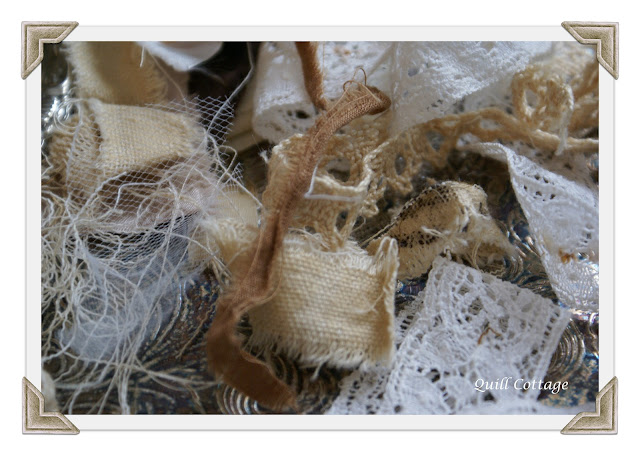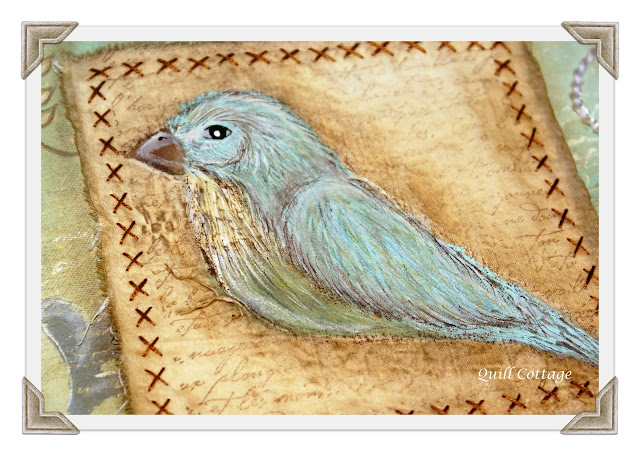"The Spice-Tree lives in the garden green,
Beside it the fountain flows,
And a fair bird sits in the boughs between,
And sings his melodious woes.
That out bound stem has branches three,
On each a thousand blossoms grow,
And old as aught of time can be,
The roots stand firm in the rock below."
~The Spice-Tree, John Sterling~
(The quote at the top of the post appears on this work.)
The majority of the time my creative process is pretty willy-nilly. I don't set time constraints or limits to when I need to get projects finished unless they are for a specific deadline, hence the drawer in my studio filled with half baked works in progress. Through working on this series I learned a really valuable lesson in setting artistic goals, keeping sight of them, and eventually meeting them.
I confess that at one point I got completely lost, not in a good way, during the creation process and it was a total road block. I could not see the next step or figure out where I was going. I found myself forcing ideas that did not feel right. I stepped away from the series and began a small side project that helped me to clear my mind. I had an "aha moment" when I asked myself exactly what my beginning goal(s) was when I started this project. Once I had firmly defined that it was like a breath of fresh air that revived my creative spirit and took the pressure off.
(I used lots of layers of paint to create depth and texture to the flat fabric surface.)
My goal was to try and see if I had the staying power to complete a 3 piece 16x20 canvas series of work based on the same subject matter, using the same color palette, exploring fabric, paper, and paint techniques that incorporate stitch and typography. My goal was not to create something that would be the next big thing or
trend. Nor was it my goal to create something that was for publication, presentation, or
profit, although that might be a future goal. This was supposed to be a simple exercise in finding, defining, and refining my artistic style.
This is what I learned: A clearly defined set of artistic goals can and will help you to move forward with your work. They are also, at least for me, a liberation or freedom to create within a set of perimeters that take a lot of guess work or angst out of the process. In the absence of a clearly defined goal you can get lost in the execution.
(Paper, paint, wire, beads, and resin create unique leaf elements.)
TIP: Work SMART(er) not harder! Chris Brogan simplified goal setting by using the acronym SMART:
Specific: Be specific and straightforward about what your goal is, why you are pursuing this goal and what you hope to accomplish, as well as how you are going to do it.
Measurable: Choose your goal with measurable progress in mind, setting small goals for process steps during each phase of your artwork, this will ultimately lead you to achieve the large end goal you have set. Measuring your progress helps you to stay on track.
(This piece also contains a kiss of metal to contrast the hard and soft of the materials.)
Attainable: Don't set your goal too far out of your reach or you will lose heart and not commit to follow through. It's kind of like saying you are going to lose 20 pounds in 7 days before your high school class reunion, it is not obtainable or even possible. A goal needs to stretch you slightly so you feel you can do it.
Realistic: This means "do-able." A realistic project may push your creative skills and knowledge but it should not break you. You want to set the goal high enough that you have to obtain it with some effort but not so difficult that it sets the stage for failure. You want a healthy balance of satisfied achievement.
Timley: You need to set a time frame for your goal. Putting this end point to your project will give you a clear target to work towards. Sometimes when we don't have a time limit the project tends to not happen because we get in the mentality of needing to be inspired to work, or there is no sense of urgency to start or take action, or you begin to feel as if you can do this at any time. Case in point: my drawer of unfinished works in progress!
(This background was woven with the intention of a vertical stripe pattern.)
I am a very strong starter but a not so strong finisher, these guidelines really helped me in setting clear, reasonable, and obtainable artist goals.
Confession number two: This was not always a fun or enjoyable process, hence the emphasis on the "work" part of artwork! I was just about out of mind by the time I got the weaving done for the third canvas. I really truly seriously wanted to quit. This opportunity to stretch myself was, "...dressed in overalls and looked like work!" (Thomas Edison quote) Trust me, there were some melodious woes being sung during this process.
(Various hand stitches were also use to enhance this design.)
I also confess that this style of working, in a series with set goals and perimeters, was extremely hard for me. It truly was an exercise is self-discipline that stretched me just enough that my "won't give up, won't give in spirit" kicked in and helped me bring this project to completion. The end result brought about an immense sense of satisfaction and accomplishment, the reward was worth the effort. I now know I can discipline myself to setting, executing, and accomplishing my artist goals one step at a time.
(Part two of the series complete!)
I am off to set my sights on a new goal.
Do you have a goal setting process to getting your artful dreams accomplished?
Do you have an tips or secrets to share?

























































